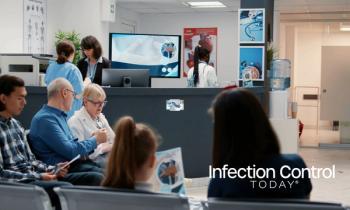
- Infection Control Today, July/August 2023 (Vol. 27 No 6)
- Volume 27
- Issue 6
The Hardest Question in Infection Control: Did You Perform Hand Hygiene?
Everyone in health care knows the importance of hand hygiene, but adherence in health care is often below 50%, and having a conversation regarding hand hygiene adherence with a coworker can be uncomfortable. What can an organization do to increase hand hygiene adherence?
“Clean hands save lives.” “Save lives: Clean your hands.” “Washed hands are caring hands.” “The number 1 way to prevent health care–acquired infections (HAIs) is to wash your hands.” These are only a few sayings commonly heard and promoted in the medical field, but are these sayings true? The answer is an overwhelming yes. The CDC estimates that approximately 1.7 million patients acquire HAIs while hospitalized and more than 98,000 of those patients (1 in 17) die because of HAIs annually.1 Although it is difficult to quantify the number of HAIs directly linked to poor hand hygiene, per the World Health Organization, appropriate hand hygiene can prevent up to 50% of avoidable HAIs, including those affecting health care workers (HCWs).2
Good and Bad Germs
Those working in infection control and prevention know the significance of maintaining proper and consistent hand hygiene. In case you need a refresher, here’s why it’s vital to keeping patients and staff safe. Hands are an essential body component and are used by HCWs when caring for their patients; however, they are filled with thousands of germs. Two types of bacteria live on our hands: resident and transient flora. Resident flora consists of microorganisms that can be found under the stratum corneum, the outermost layer of the epidermis, and on the surface of the hands. Common resident species include Staphylococcus epidermis, Staphylococcus hominis, and other coagulase-negative staphylococci. Resident flora has 2 essential protective functions: the competition for nutrients in the ecosystem and microbial antagonism.3 These functions serve as a body defense by inhibiting the growth of other disease-producing organisms. Although resident flora is less commonly linked with infections, it may cause infections in sterile body cavities, the eyes, or on nonintact skin.4 As the name implies, resident flora is a common and expected presence on our hands. Normal hand hygiene is not intended to eliminate resident flora.
Transient flora on the hands is removed by performing hand hygiene and has been commonly linked to HAIs. Transient flora is acquired during direct contact with contaminated individuals or surfaces and lives in the superficial layers of the skin. Typical transient flora includes Staphylococcus aureus, gram-negative bacilli, and yeast.
How Do These Bacteria Affect Health Care?
We have established that individuals have good and bad bacteria on their hands, but how do they affect health care? According to the CDC, health care providers might need to clean their hands as many as 100 times in a 12-hour shift, depending on the number of patients and intensity of care. Nevertheless, findings from studies show that health care providers clean their hands fewer than half the times that they should. This lack of hand hygiene contributes to the spread of HAIs that affects 1 in 31 hospital patients on any given day.5
As we all know, an increase in HAIs affects patients, their families, and the health care system. Hospitals are affected by low patient satisfaction related to poor outcomes such as HAIs, increased risk of antibiotic resistance, and consequences including lawsuits, fines, and even loss of accreditation. The direct medical costs of HAIs for hospitals in the United States range from $28.4 to $33.8 billion annually.6 Most importantly, patients are negatively affected by increased morbidity and mortality when HAIs are acquired, adding to their illness and care.
Why Don’t HCWs Wash Their Hands?
Many factors prevent HCWs from performing hand hygiene, including the lack of access to hand sanitizers or sinks, time constraints, skin sensitivity, education, and training, and personal beliefs. These factors have been widely researched, and many techniques and instructions are available for infection control departments and organizations to address them. However, the importance of a speak-up culture should be talked about more. Nothing is more terrifying than going up to a coworker, physician, or leader and asking them, “Did you perform hand hygiene?”
Speaking up for patient safety should be an HCW’s priority. However, many
barriers may prevent an HCW from speaking up about the importance of hand hygiene to a coworker. Some of the key barriers include the following:
Lack of confidence.
Some HCWs may need more confidence to speak up about hand hygiene. They may feel uncomfortable confronting their coworkers or worry about being perceived as bossy.
Fear of upsetting coworkers.
An HCW may hesitate to speak up because they fear their coworker may take their feedback personally or become defensive.
Lack of knowledge.
An HCW may not feel confident
in their knowledge or training
on the organization’s hand
hygiene practices.
Time constraints.
Health care is a dynamic field, and employees may feel they do not have time to converse about hand hygiene.
Language or
cultural barriers.
Staff from different cultural or language backgrounds may have different beliefs and attitudes about hand hygiene or providing feedback.
What Can Medical Facilities Do What Can Medical Facilities Do
to Increase Hand Hygiene Adherence?
Organizations can incorporate multiple strategies to improve their speak-up culture. Some of these strategies may include:
Education and training.
Providing education and training on the importance of hand hygiene will increase awareness and understanding of hand hygiene adherence and the responsibility for speaking up. Education can include in-person sessions, online modules, posters and signage, and reminders during staff meetings or huddles.
Leadership support.
Organizational leaders serve as examples to others. Leaders who consistently practice good hand hygiene, provide feedback, and are open to ideas and suggestions will encourage others to follow suit.
Feedback and recognition.
Organizations will often provide just-in-time training to HCWs who have performed an adverse action; however, providing positive feedback and recognition will help reinforce good behavior and encourage their peers to do the same.
Empowerment.
Organizations can empower HCWs by creating a culture of openness and providing channels for reporting concerns. An option for anonymous reporting should be offered, and emphasis should be put on the fact that no retribution will be tolerated.
Create a phrase that saves.
Coming up to a coworker and asking them directly whether they have performed hand hygiene may seem like a confrontational or accusatory way to start a conversation. Creating an organizational “phrase that saves” will prevent aggressive or accusatory feelings. A phrase that saves is an expression adopted by an organization that is given a special meaning. Everyone in the organization should know the phrase and the meaning behind it. An example of a phrase that saves is “Clean 20,” used by Santa Clara Valley Medical Center’s O’Connor Hospital in San Jose, California. To all O’Connor Hospital staff and physicians, “Clean 20” means there is an opportunity to perform hand hygiene. For example, Nurse A is outside a patient’s room charting when they notice Doctor B leaving the patient’s room without performing hand hygiene. Instead of Nurse A telling the doctor to perform hand hygiene, they gently tell Doctor B, “Clean 20.” The doctor knows the phrase that saves, so they perform hand hygiene and thank Nurse A.
The importance of hand hygiene in health care cannot be overstated because it is the most effective way to prevent HAIs. Adherence to hand hygiene practice by HCWs is far from what it should be, allowing for many improvement opportunities across health care organizations. Among those opportunities, the promotion of speak-up culture needs to be incorporated. Speak-up culture can provide an environment that supports and empowers HCWs to engage in conversations when opportunities for hand hygiene are observed. This important component of education helps to extend the reach
References
1. Klevens RM, Edwards JR, Richards CL Jr, et al. Estimating health care-associated infections and deaths in U.S. hospitals, 2002. Public Health Rep. 2007;122(2):160-166. doi:10.1177/003335490712200205
2. Key facts and figures. World Health Organization. 2021. Accessed June 2, 2023. https://www.who.int/campaigns/world-hand-hygiene-day/2021/key-facts-and-figures
3. Kampf G, Kramer A. Epidemiologic background of hand hygiene and evaluation of the most important agents for scrubs and rubs. Clin Microbiol Rev. 2004;17(4):863-893. doi:10.1128/CMR.17.4.863-893.2004
4. Lark RL, VanderHyde K, Deeb GM, Dietrich S, Massey JP, Chenoweth C. An outbreak of coagulase-negative staphylococcal surgical-site infections following aortic valve replacement. Infect Control Hosp Epidemiol. 2001;22(10):618-623. doi:10.1086/501832
5. Clean hands count for safe healthcare. CDC. February 25, 2020. Accessed May 31, 2023. https://www.cdc.gov/patientsafety/features/clean-hands-count.html
6. Scott RD II. The Direct Medical Costs of Healthcare-Associated Infections in U.S. Hospitals and the Benefits of Prevention. CDC; 2009. March 2009. Accessed June 3, 2023. https://www.cdc.gov/HAI/pdfs/hai/Scott_CostPaper.pdf
Articles in this issue
about 2 years ago
Bug of the Month: I Like to Hang Aroundabout 2 years ago
Handling Exposure Cases with Compassion and EmpathyNewsletter
Stay prepared and protected with Infection Control Today's newsletter, delivering essential updates, best practices, and expert insights for infection preventionists.






